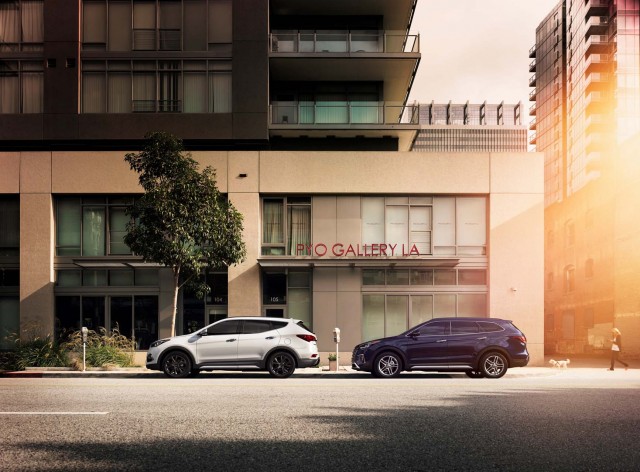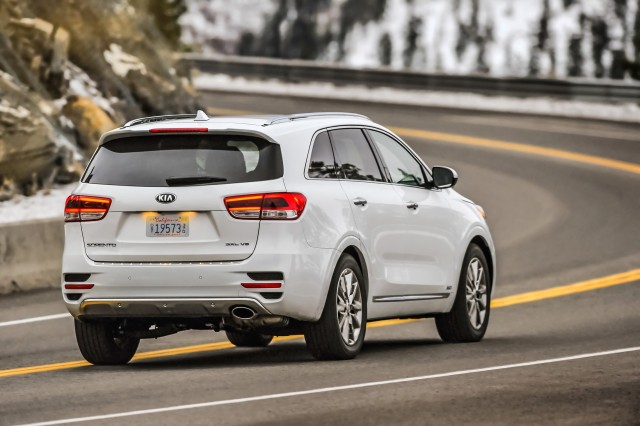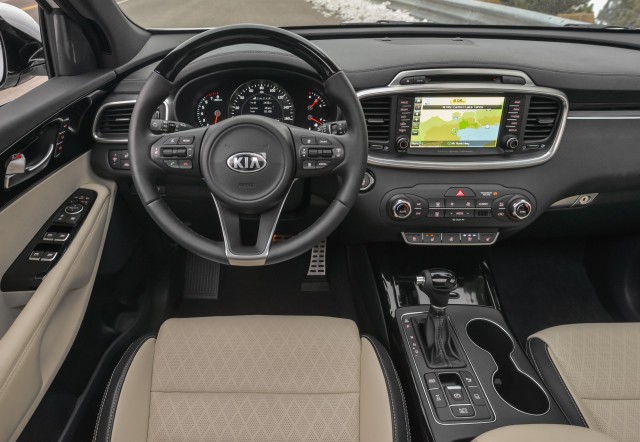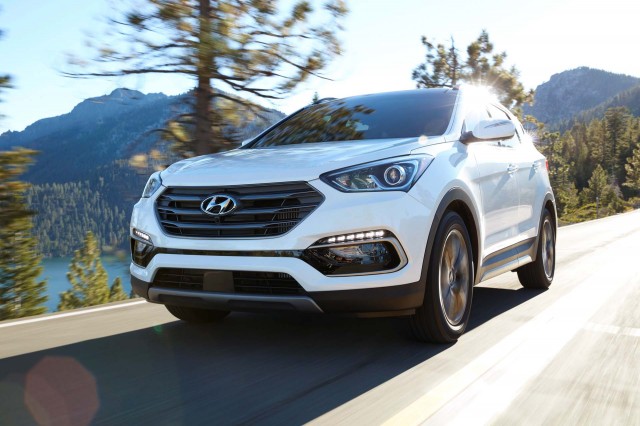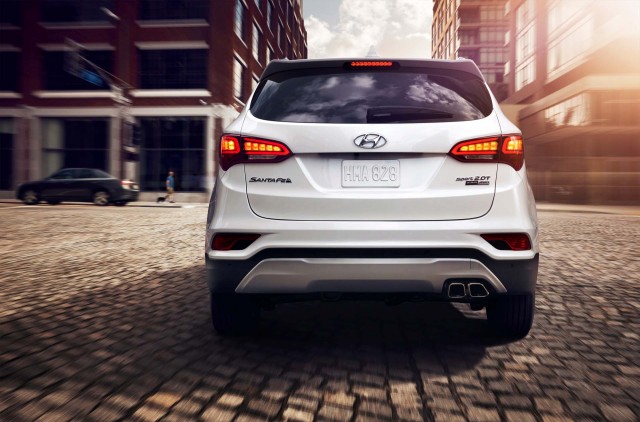2017 Hyundai Santa Fe Sport vs. 2017 Kia Sorento: Compare Cars
The 2017 Kia Sorento and 2017 Hyundai Santa Fe Sport serve slightly different parts of the crossover SUV market. That’s because the Sorento offers a third-row seat and a 2016 redesign makes it larger. The two come closest when outfitted with five-passenger seating. In this guise, they compete with the likes of Honda CR-V, Ford Escape, Chevy Equinox, and even the Jeep Grand Cherokee. Add that third row to the Sorento, however, and it competes with larger vehicles like the Honda Pilot and Toyota Highlander.
Both models serve families well, with a nice balance of comfort, space, and value. Using our new rating system, the Sorento scores a 7.2, the Hyundai a 7.3—so it’s a close battle. (Read more about how we rate cars.)
While every bit of the Kia’s sheet metal and every piece of trim have changed, it’s understandable that someone may not see too much difference between the 2016 and 2015 models. From all but the side, the Sorento’s proportions look quite familiar, yet with a more prominent version of the Kia grille; some cleaned-up, more mature, upscale details in front and in back; and a little more softness for everything in between. The cabin of has been quite dramatically tidied-up and made more sophisticated, too, with more soft-touch trims all around—wherever front occupants are expected to typically touch—and climate and navigation/audio controls cordoned off into nice, neat control pods.
Similarly, the Santa Fe Sport has an attractive shape that looks modern and grown-up. Updated for 2017, its sharp edges and tight creases wrap around the glassy wagon body in interesting ways, and the grille presents a handsome hexagonal face. Between the Tucson and larger Santa Fe, we say the Santa Fe Sport wears the new corporate SUV style the best. The interior is another bar raised for Hyundai, with a shield of controls surrounded by the usual swoops and fluid curves. It’s all trimmed in two-tone materials, an upscale touch that looks better when it’s capped in glossy trim than in faux wood.
Of the two we give the styling nod to the Sorento for its slightly more upscale look.
We also prefer the Sorento’s performance. From the driver’s seat, it’s easy to feel that there’s been major improvement in the way the re-engineered Sorento responds. Steering tracks well on center, the brake feel inspires confidence, and the suspension keeps a firm, composed ride. Altogether, the Sorento has what Kia set out to achieve: a vault-like, German-style ride and a heftier, more confident feel in general—even though the lineup has lost some weight.
The Santa Fe Sport’s driving experience is mostly effortless and smooth. Ride quality is probably the Santa Fe Sport’s best feature—it’s almost always calm and collected—but its three-mode steering is mostly there for technological flourish. We’d just as soon leave it in Normal or Sport, because Comfort’s just too slow to respond.
The Sorento also offers a wider range of engines and more towing capability. Kia offers a 185-horsepower 2.4-liter inline-4, a 290-hp 3.3-liter V-6, and a new turbocharged 2.0-liter inline-4 making 240 hp and 260 pound-feet of torque. While the V-6 might have 50 more horsepower, the 2.0-liter turbo feels perkier in most types of driving—all but off-the-line acceleration. The Sorento can tow up to 5,000 pounds with the available V-6 and it offers all-wheel drive with a differential lock that locks in a 50/50 front/rear split.
The Santa Fe Sport, by comparison, has a naturally aspirated 2.4-liter inline-4 making 190 horsepower, or a turbocharged 2.0-liter inline-4 with 264 hp. The turbo four provides an altogether more pleasant driving experience, with acceleration to 60 mph in the seven-second range. Its all-wheel-drive system lacks a differential lock, and the maximum towing capacity is 3,500 pounds.
The Sorento offers the better fuel economy of the two. With front-wheel drive and the 2.4-liter four-cylinder, fuel economy reaches 21 mpg city, 29 highway, 24 overall. With the V-6 and all-wheel drive fuel economy is as low as 18/26/21 mpg. By comparison, the Santa Fe Sport tops out a 21/27/24 mpg with the 2.4-liter four-cylinder engine, but falls as low as 19/26/22 mpg with the 2.0-liter turbo four and all-wheel drive.
2017 Hyundai Santa Fe Sport
2017 Hyundai Santa Fe Sport
2017 Hyundai Santa Fe Sport
Comfort, utility, and safety
Inside, the Sorento offers a third-row seat, to bump its capacity from five up to seven. The cabin is also a bit more usable than both the last model and that of the Santa Fe Sport thanks to three more inches of wheelbase and three more inches of overall length. In top SX and SX-L models, the driver’s seat has extendable thigh bolsters—definitely of use to taller drivers. Second-row accommodations are essentially the same for two- and three-row versions, though you get an underseat storage system in two-row models. The third row is best for kids, but it it will do just fine for a quick dinner outing for a pair of adults under 5-feet-10-inches tall.
The Santa Fe Sport offers plenty of utility, too. The front seats are supportive, but the second row is where the action is: on some models, the second row slides on a 5.2-inch track for better flexibility. The seat also reclines and folds on a 40/20/40 split, making way for longer objects while preserving four seating positions. There’s also some storage space below the cargo floor. Overall, the Sorento offers better interior flexibility, but the Santa Fe Sport’s second-row seat is the better choice if a third row isn’t needed.
The safety story is a Hyundai win. The Sorento is available with Hill-Start Assist, a back-up warning system, a blind-spot warning system and rear cross-traffic alert, lane departure warning, forward collision warning, an around view monitor, and adaptive cruise control, though most of those features are only available on the top-of-the-line model. The Santa Fe Sport gets an IIHS Top Safety Pick+ award and a five-star NHTSA rating, just like the Sorento—but the Sorento doesn’t come with a standard rearview camera.
Value and features for the money have always been integral to both brands, though the Sorento is beginning to move upscale. It starts at a reasonable price of roughly $26,000, but the high-end SX-L with the 2.0-liter turbo or the V-6 tops $42,000. LX and EX models are the heart of the market, and EX models can be had with the turbo four or the V-6 for about $32,000.
With a base price of about $26,000, the Santa Fe Sport makes the usual Hyundai case for value. It gets plenty of features at that price and doesn’t rise much above the low $30,000 range when sensibly equipped.
All things considered, the Santa Fe Sport is our higher rated vehicle and it has some advantages even where our ratings are the same. However, pricing for the Sorento rises into premium territory for the higher trim levels, and it’s easier to keep the Santa Fe Sport’s price in check. We can happily recommend both of these vehicles, but we prefer the updated materials and new look for the Santa Fe Sport.
2017 Kia Sorento vs 2017 Hyundai Santa Fe
When it comes to power under the hood, the 2017 Kia Sorento has a lot to offer. The Hyundai has a larger standard engine, but at a much higher MSRP and lower fuel economy rating both in the city and on the highway. The 2017 Kia Sorento comes with a standard four-cylinder engine, paired with a six-speed automatic transmission. On top of that, the Sorento achieves 21 miles per gallon in the city and 28 miles per gallon on the highway. The exterior design of the Sorento and the Santa Fe look similar in size and shape, but the Kia’s exterior has more confidence because of the recently redesigned headlights and tiger nose Kia grille.
When it comes to the interior, the Kia Sorento’s high-tech interior offers a comfortable and functional layout. Both vehicles offer a stylish and modern look, and have standard seating for five passengers in comfortable Yes Essentials Premium Cloth seats. Each SUV has a six-speaker audio system and standard Bluetooth compatibility for making hands-free phone calls and playing your favorite tunes.
A host of active safety features are available on the 2017 Kia Sorento, giving you the option of adding extra confidence to the daily drive. Keeping the driver and passengers safe is the number one job of these features, but they give you the added benefit of easier driving. With features like a rear view camera and rear cross-traffic, you’ll be driving in reverse with fewer worries than ever before.
Comparison — Hyundai Santa Fe Limited Ultimate 2017 — vs — Kia Sorento EX 2017
For 2017, the Hyundai Santa Fe returns with refreshed front and rear styling that’s highlighted by new LED daytime running lights. Inside, there’s a 7-inch touchscreen that’s standard for even the base SE trim level and an available USB charging port for the third row. On the safety front, a 360-degree parking camera system, adaptive cruise control, lane departure warning and automatic emergency braking for forward collision mitigation are newly available this year.
Pros
Strong V6 engine provides quick acceleration
Plenty of standard features for the money
Interior features classy design and easy-to-use technology interfaces
Warranty coverage is generous.
Cons
Cargo capacity isn’t as large as some competitors.
The sharper-looking 2017 Hyundai Santa Fe is still a good value for families looking for a three-row hauler—but its powertrain is starting to show its age.
For 2017, the Hyundai Santa Fe has received a significant overhaul. The Santa Fe is the larger, three-row crossover SUV that’s related to the smaller two-row Santa Fe Sport.
Pros
Better look for 2017
Still good value for money
Excellent cargo space
Standard models still well-equipped
Strong V-6
Cons
All-wheel-drive penalty is sharp
Could use newer transmission
Third-row seat space is slight, compared to rivals
The 2017 Hyundai Santa Fe ranks 3 out of 18 Midsize SUVs. The Hyundai Santa Fe has impressive safety, comfort, and infotainment features, and it delivers solid performance, though the Sport model’s base engine is average at best. The Santa Fe’s cabin is full of technology that will keep drivers and passengers safe, comfortable, and entertained.
Pros
Strong V6 engine in Santa Fe
Generous list of standard features
Cons
Weak base engine in Sport models
Underwhelming acceleration
The 2017 Kia Sorento stays true to its high-value roots, but it’s grown up in refinement and comfort.
Kia Sorento received a full redesign, with completely new sheet metal, a new body structure, a newly available turbocharged inline-4 engine, plus modest gains in interior space and major gains in general cabin comfort and ride quality.
Pros
Tight, «vault-like» feel
Generous feature set
Responsive, economical 2.0T
Quiet cabin
Cons
Short, bench-like second-row seats
Can’t get a third-row seat and turbo-4 engine together
Active-safety features not widely available
The 2017 Kia Sorento ranks 1 out of 18 Midsize SUVs. The 2017 Kia Sorento is a versatile crossover that rates highly in a competitive class thanks to a powerful V6 engine, many user-friendly tech features, and the availability of third-row seats. It also has excellent safety and reliability ratings, and its low starting price makes it a great value.
Pros
Easy to use infotainment system
Potent V6 engine
Stable handling
Quality interior
Cons
Weak standard engine
Limited options for base model
The 2017 Sorento can now be had with Apple CarPlay and Android Auto smartphone integration, along with a couple of new safety features (adaptive headlights and automatic emergency braking). Also, the EX 2.0T gets standard shift paddles, but the SX Limited is no longer offered with the 2.0T engine.
Pros
Controls are easy to operate
Cabin is well-made and attractive
Second-row seats are versatile and comfortable
Strong value proposition
Excellent warranty
Top crash-test scores.
Cons
Turbo engine isn’t as punchy or efficient as expected
Most seven-passenger competitors offer more interior space.
